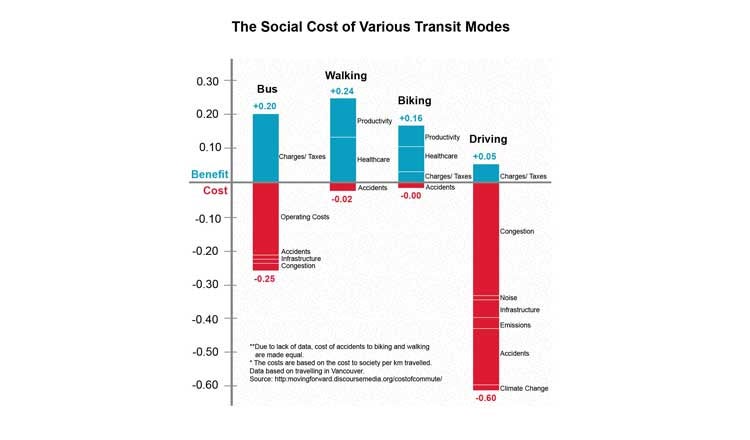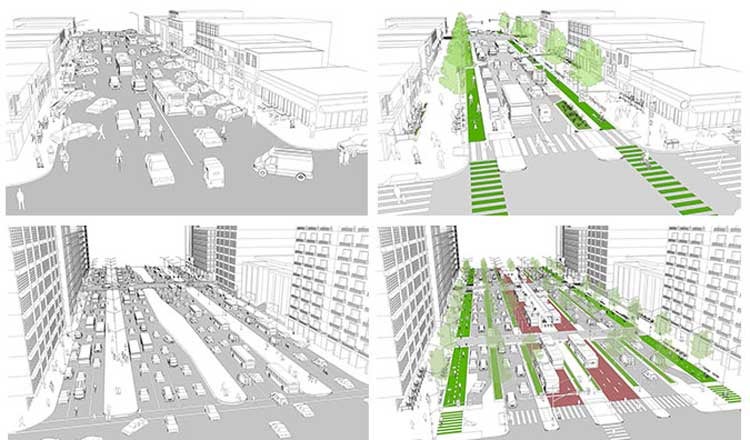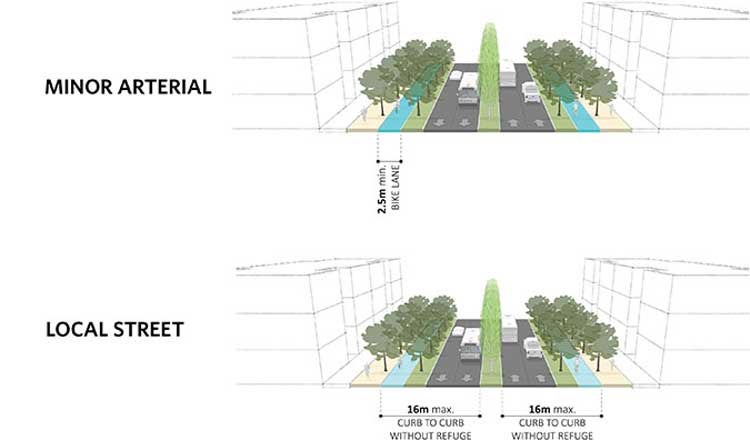
Ending Global Sprawl: Design for Walking and Biking
This article was originally published in Ending Global Sprawl: Urban Standards for Sustainable and Resilient Development, written by Peter Calthorpe and published by the World Bank's Global Platform for Sustainable Cities. Ending Global Sprawl explores forward-thinking planning strategies for the urban form.
Principle 7: Design for Walking and Biking
Prioritize walking and biking with ubiquitous safe, direct and comfortable routes.
Rationale and Challenges
Walkable and bikeable streets and neighbourhoods are the foundation of every great city. Walking reduces auto-dependence, supports public transit, improves health, enhances local shops and promotes community. Unsafe environments discourage walking and biking, which, in turn, make the shift to a high share of non-motorised transit difficult. At once ancient and modern, walking is at the core of high-quality and humane neighbourhoods all over the world. The most attractive cities in the world emphasize the pedestrian environment and human scale in public spaces, activities and buildings.
The challenges of enhancing active transport vary dramatically throughout the globe, but on average, non-motorised transport represents a significant portion along with transit. Generally, walking dominates this category of nonmotorised transport representing, on average, twice the mode split as biking. In fact, non-walking modes are undergoing a renaissance of new technologies such as electric-assisted bikes, e-scooters and e-tricycles. These configurations are proliferating rapidly and are sure to enhance local trips and first/last mile connections to transit.
Each of the three forms of global sprawl represents different opportunities and challenges for walk/bike trips. In areas of high-income sprawl, auto ownership is so high that roadways and land use have been largely configured for their use. Land uses are isolated, and streets are inhospitable to pedestrians. In these areas, adding density, transit, and local destinations must go hand in hand with investments in safe sidewalks and bikeways. In areas of high-density sprawl, reforming the block structure to allow pedestrian permeability and safe bikeways should be foremost. For these areas, additional local destinations along with auto-free streets are viable and desirable. In low-income sprawl areas, the fundamental need is to develop right-of-way space, as many informal areas lack a basic street network sufficient to supplement roadways with sidewalks and bikeways.
Finding funds to support roadway improvements for walk/bike lanes are major challenges, as are securing funds for other basic services such as water, power and sewers. Nonetheless, enhancements and upgraded streets can efficiently combine needs for infrastructure with walk/bike space and even street trees.

Goals and Actions
7A: Emphasize pedestrian safety, comfort and convenience
- ACTION 1: Plan sidewalk dimensions in proportion to surrounding density and uses
- ACTION 2: Plan for consistent street trees and pedestrian amenities
- ACTION 3: Create ‘bulb outs’ at street corners, replacing parking lanes to reduce crossing distance
7B: Encourage ground-level activity and create places to relax
- ACTION 4: Line streets with visually active frontage and eliminate parking in front setbacks
- ACTION 5: When block security is required, provide semi-transparent fencing design with setbacks for landscaping
7C: Design streets that emphasize bike safety and convenience
- ACTION 6: Protect bike lanes with physical barriers from cars and clear pedestrian separation
- ACTION 7: Consider the use of auto-free streets

Metrics
7.1: Sidewalk Size
Sidewalks should provide a minimum of 3.5-meter-wide walkway on streets with four or more lanes, and a minimum of 2.5-meter-wide walkway for two-lane streets
7.2: Street Crossings
Street crossings should be 16 meters maximum curb-to-curb in the absence of a refuge
7.3: Active Street Frontage
Provide a minimum of 20% of residential block perimeter dedicated to publicly accessible uses and 60% in commercial blocks and along shopping streets
7.4: Bike Lanes
Streets with four or more lanes must have protected bike lanes of at least two meters each direction

Benefits
Economic
- Increases property values: As has been shown in cities all over the world, there is a price premium in walkable neighbourhoods.
- Increases returns on investment: Bike-share systems can produce many benefits; in New Zealand, the benefits were 10 to 25 times the cost.
- Decreases government costs: Governments avoid cost externalities from health, congestion and pollution when there is less driving and more biking and walking.
- Relieves congestion: Improving the walking and biking experience is the best way to reduce car use. For example, Guangzhou’s bike-share program prevents 14,000 car trips daily.
- Decreases transport costs: Substantial savings on fuel, maintenance and parking costs are achieved with more walking and biking.
Environmental
- Reduces carbon emissions: Biking and walking produce no tailpipe emissions. In contrast, car traffic is an increasing source of carbon emissions and other toxic emissions.
- Improves air quality: Motor vehicle emissions contribute significantly to particulate matter levels and other damaging air pollutants. The transportation industry is responsible for one-fifth of global carbon dioxide emissions; a majority of those emissions originate from passenger vehicles.
Social
- Improves physical health: Walking contributes to heart health and reduces the incidence of cancer. By contrast, vehicle emissions contribute to many documented illnesses, such as asthma.
- Improves equality: As biking and walking are inherently less expensive transit modes, more citizens can afford the costs of biking or walking than driving.
- Decreases risk of injury: Adding more bike lanes can decrease accidents and injuries for everyone on the road, not just bicyclists.
- Promotes age equity: Walk/bike is a universally accessible mode of travel and allows all age groups to access critical destinations and services easily and at a low cost.
ENDING GLOBAL SPRAWL Book Overview
About the Author: Peter Calthorpe

Peter’s long and honoured career in urban design, planning and architecture began in 1976, combining his experience in each discipline to develop new approaches to urban revitalisation, suburban growth and regional planning. In 1983, Peter founded the award-winning firm of Calthorpe Associates devoted to sustainable urban design and planning globally. In May 2019, Calthorpe Associates joined HDR. Throughout his career in urban design, planning and architecture, he has been a pioneer of innovative approaches to urban revitalisation, community planning and regional design. For his contribution in redefining the models of urban and suburban growth, he was awarded Urban Land Institute's prestigious J.C. Nichols Prize for Visionaries in Urban Development in 2006. He is one of the founders and the first board president of Congress for the New Urbanism. Metropolis Magazine claims: "The titles of Peter Calthorpe’s books define the recent history of urban design in its most vital and prescient manifestations."

